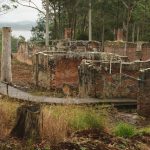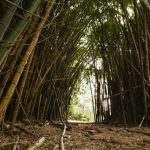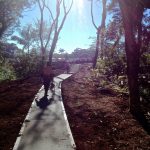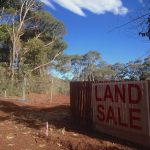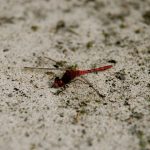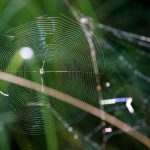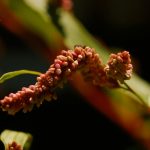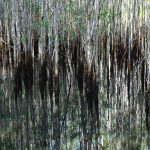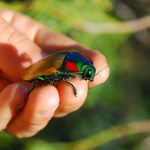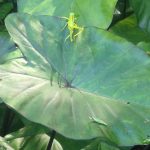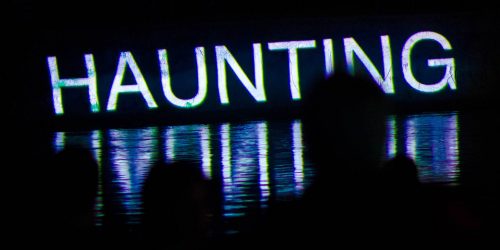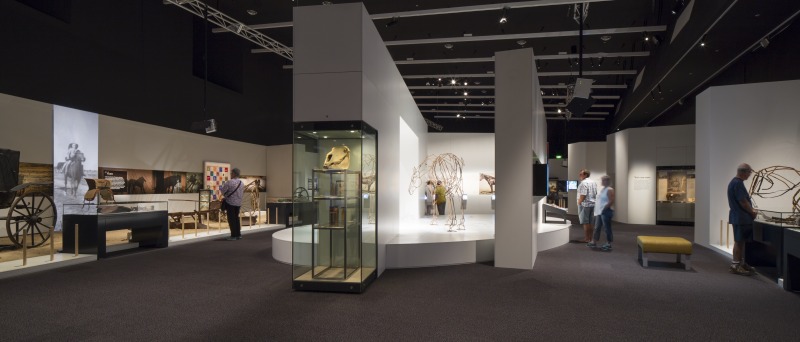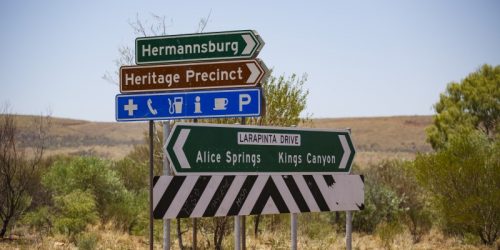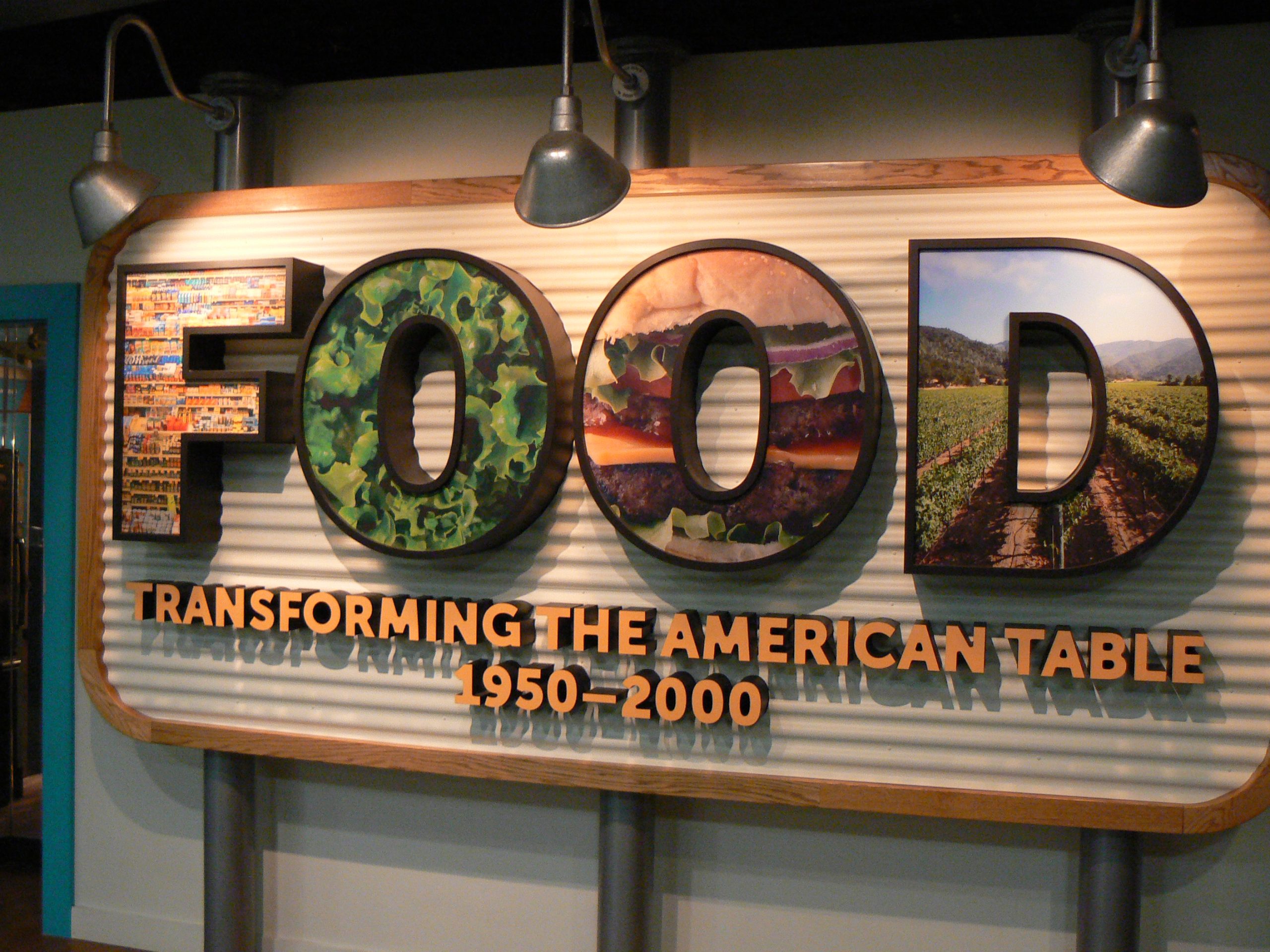A Botanical life – a new chapter
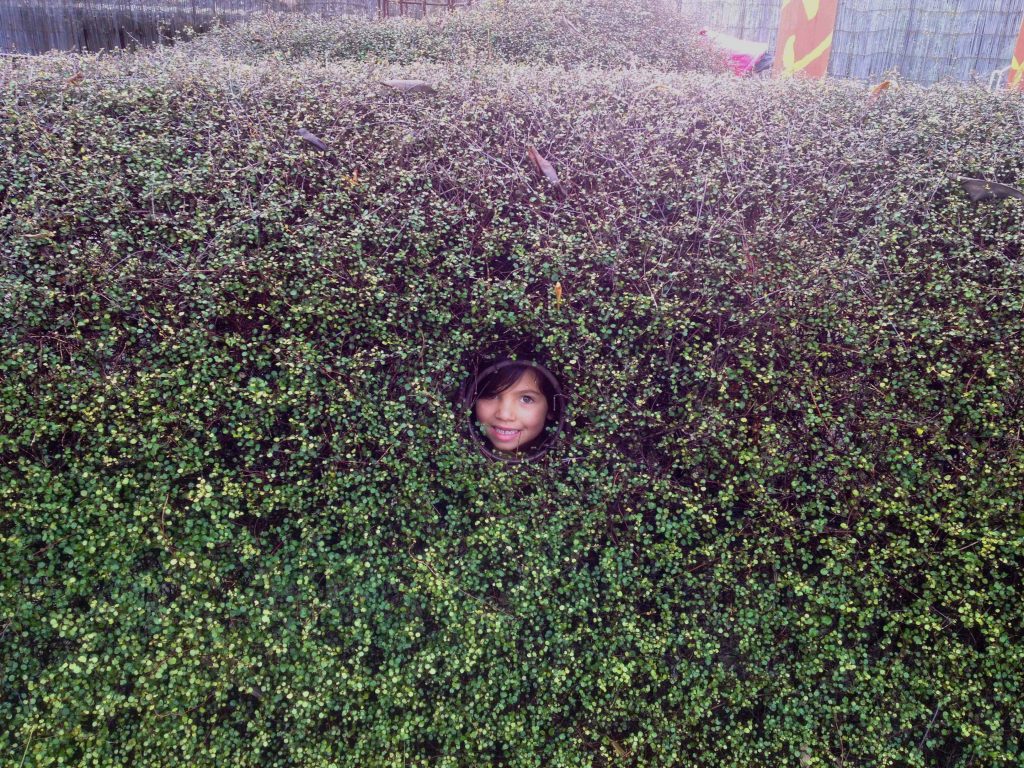
It’s truly serendipitous how the fabrics of our lives sometimes manage to weave themselves into fortuitous little knots of connection, and it seems that just such a knot led to this guest blog post – exploring two women’s contemporary lives in the bush – by Pappinbarra River valley resident Chay Khamsone and her neighbour-come-colleague Bryony Anderson.
You see, not long ago, I wrote an article titled “A botanical life”, which explored the life of a young girl named Annabella Innes. In the 1840s, Annabella lived at Lake Innes Estate, about 11km west of Port Macquarie, and was fascinated with the surrounding natural environment, carefully recording it in her diaries and botanical watercolours. She was an interesting young character that I became inspired to write about through my work on the Port Macquarie place story in the Museum’s Landmarks gallery, which features objects – on loan from the Port Macquarie Historical Society – related to Annabella’s life at Lake Innes Estate.
As I reflected on Annabella’s fascination with the local bush and her resultant artistic output, what suddenly struck me were the connections between this young lady and a group of young women, including Bryony and Chay (who I knew well from our Canberra school days), who are now similarly involved in a process of observing, investigating, artistically recording and effectively preserving the same region of NSW bush. Separated by over 170 years, the two obviously have their differences, such as Chay and Bryony’s contemporary practice being community-based and explicitly concerned with regenerating and preserving the local ecosystem, while Annabella’s was not. Yet what Annabella and these women obviously do have in common is a love of the bush, indeed the same patch of bush, and the fact that their affections found expression in reflective creations of botanical art. Of course, our contemporary protagonists might see it differently, but who better to tell you about that than they, so I hand over to Chay and Bryony…
Love your Bush
Chay – Yes Hipsters, and we don’t mean the one growing on your face. This guest blog post is all about the abiding love of the bush that over time has inspired residents of the Port Macquarie-Hastings region to devote significant portions of their lives to its exploration, representation, restoration and protection. For Bryony and I, this has meant taking our love for this bush on an artistic journey through a Mid-North Coast-based project called the Frugal Forest.
To provide a bit of background, I moved to the Port Macquarie area 5 and a half years ago for reasons of city-fatigue (known more happily as the tree-change impulse) – having been sprouted in Laos, grown-up in Canberra, studied-up in Melbourne and then living most recently in Brisbane. I’ve had a ball, but had enough of the niggling feeling of disconnection I found in city life. I had worked as a high school teacher for a couple of years in Brisbane, gotten myself married and wanted to raise a family in something more than a townhouse or apartment. The country was calling. Or more specifically, the bush was calling. Fond memories stashed away from a few early years spent living an idyllic life in a valley in the shadow of Middle Brother Mountain on the Mid-North Coast of NSW, began to resurface. They were of magical childhood hours spent burrowing through lantana mazes, traversing creeks by the highways of great fallen, mossy logs, and swimming in blackwater pools stained by the tannins of old trees. I wanted my kids to have the same feeling of freedom, connection and responsibility to the natural world, so when we found a place 40 minutes north of that childhood paradise, we jumped.
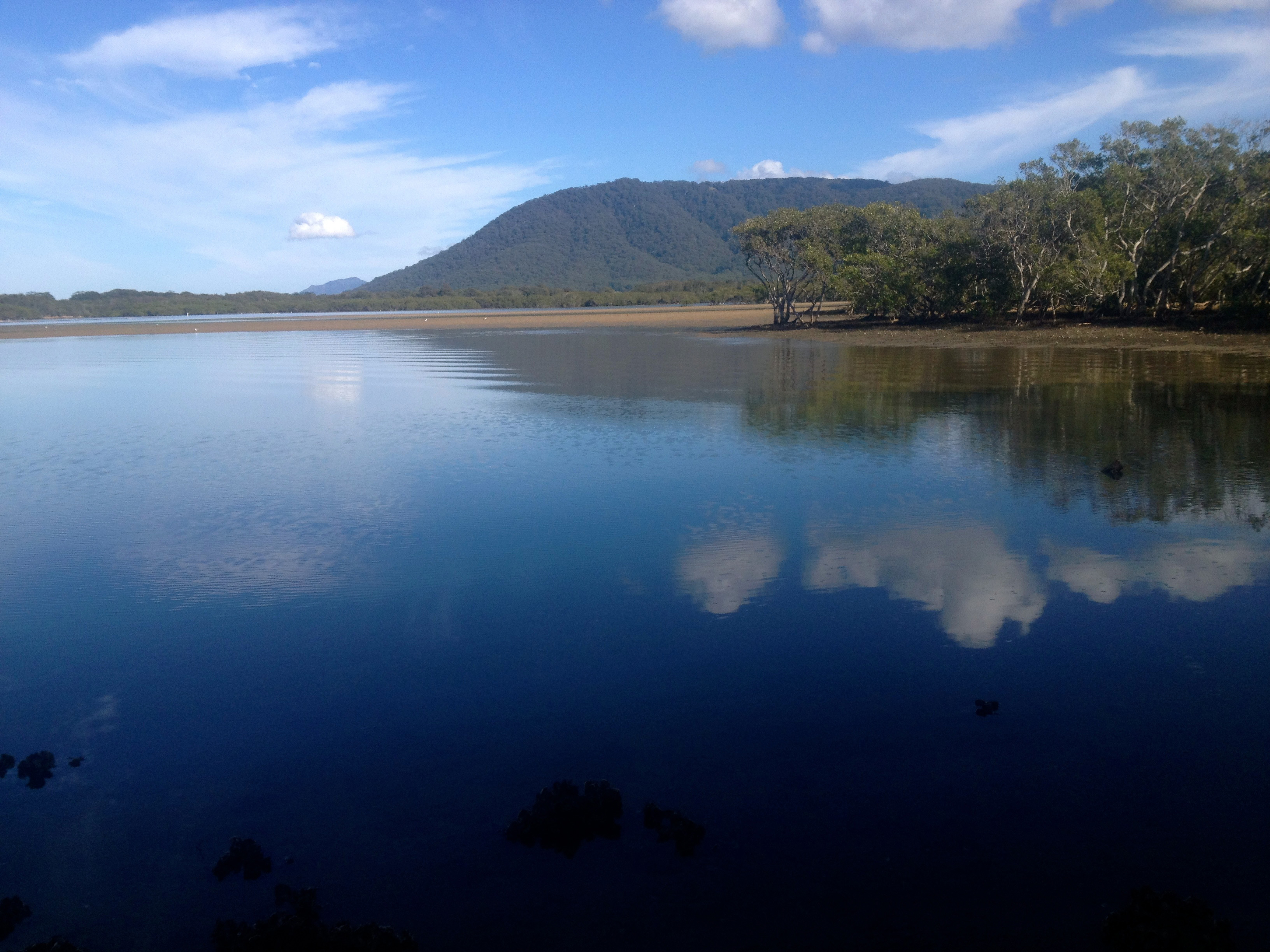
This region that we moved to (the local government area now known as Port-Macquarie-Hastings) is “Birrpai Barray”, or the country of the Birrpai people, also commonly touted in local tongue as “God’s country”. This phrase always intrigues me but yes, it indeed boasts great natural beauty. In this region there is great seasonal, geological and topological variety: from high altitudinal regions that can get a dusting of snow, with ancient, remnant Gondwanan flora all the way to coastal plains where you have many assemblages of different ecological communities (that’s my husband talking, he’s a bush nut!). Read: abundant biodiversity. Watershed comes out of the great divide, traversing lower ranges and foothills of the Hasting’s catchment on route to the coastal plain. The rivers and inlets are stunning features of the area, and the monumental three “Brother” mountains are parked along the coast south of Port Macquarie. Climatically even more “perfect” than Queensland (I’m sure I read that in a glossy brochure somewhere), it lies in the overlap of subtropical and temperate zones, supplying the perfect climatic conditions to attract a large portion of Australia’s retirees. Luckily for us, bless the retirees of course, it is also attracting many like-minded young families out of the cities.
By some freak of social meanderings, I met artist and puppet-maker Bryony Anderson, who lives in a beautifully renovated shed on the top of a hill, surrounded by hills and, well, more hills! Bryony had had similar urgings to find a home in the bush for her family after a good deal of traversing the eastern seaboard in a bus and travelling overseas for work. She found a beautiful bush-block up a dirt road that runs out of the Pappinbarra valley. She set up her solar-powered workshop there, one of its first projects being life-sized dinosaur puppets for the LA Museum of Natural History. Her workshop steadily cranked out puppets, props and artworks that were freighted around the country (and the globe), but Bryony was keen to find a way to work that was more involved with the community and relevant to local life. She started One Off Makery in 2011 with the idea of seeding a small creative industry making high calibre works from frugal resources. For a year, Pappinbarra locals worked on the Salvage Spider, a 3m long realistic Orb Spider made from dismembered teddy bears, with a web spun from their innards. From there, the idea of the Frugal Forest was born. But more about that a little further on…
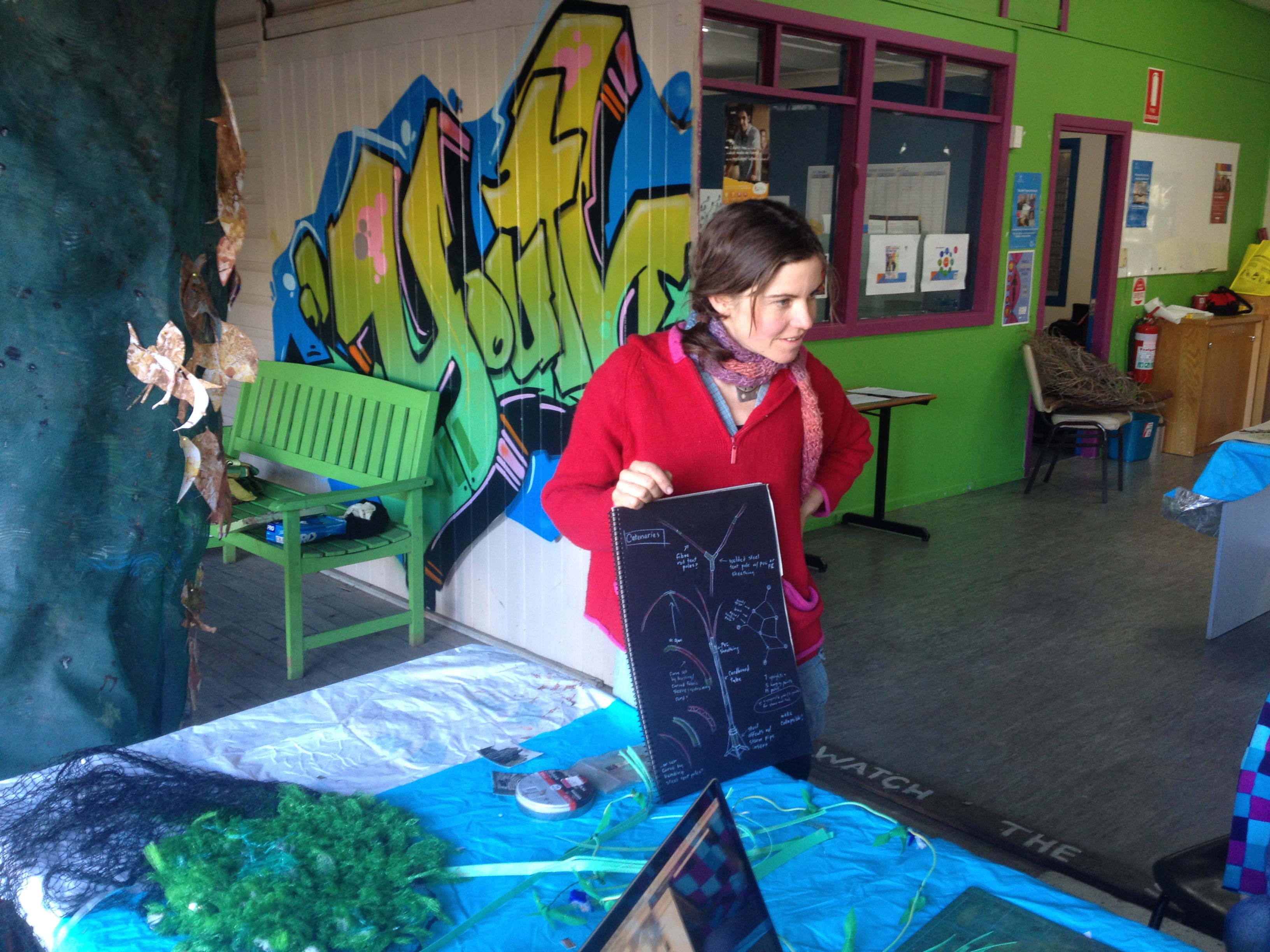
Bush Regeneration
Chay – There are many issues that threaten the bush; one of them is weeds. When asked to write this article, taking Annabella Innes’ diaries and sketchbooks as a springboard, I had to laugh. Why? Because Annabella Innes’ family hold the dubious distinction of introducing lantana to Australia. I spend two days a week working as a bush regenerator in and around Port Macquarie, my dear husband also does the same for the local council, and between us (and on our hobby farm), we have spent a lot of time pulling out lantana! And if you have been past any piece of disturbed bushland in Australia (which is most of it), you would know that lantana is a big deal. For me, looking at the connection between colonial and contemporary times, it is also symptomatic of a deleterious attitude towards the bush that travelled here with Europeans and still lingers dangerously today, embedded in our thinking, our way of life, and the global systems we have set up.
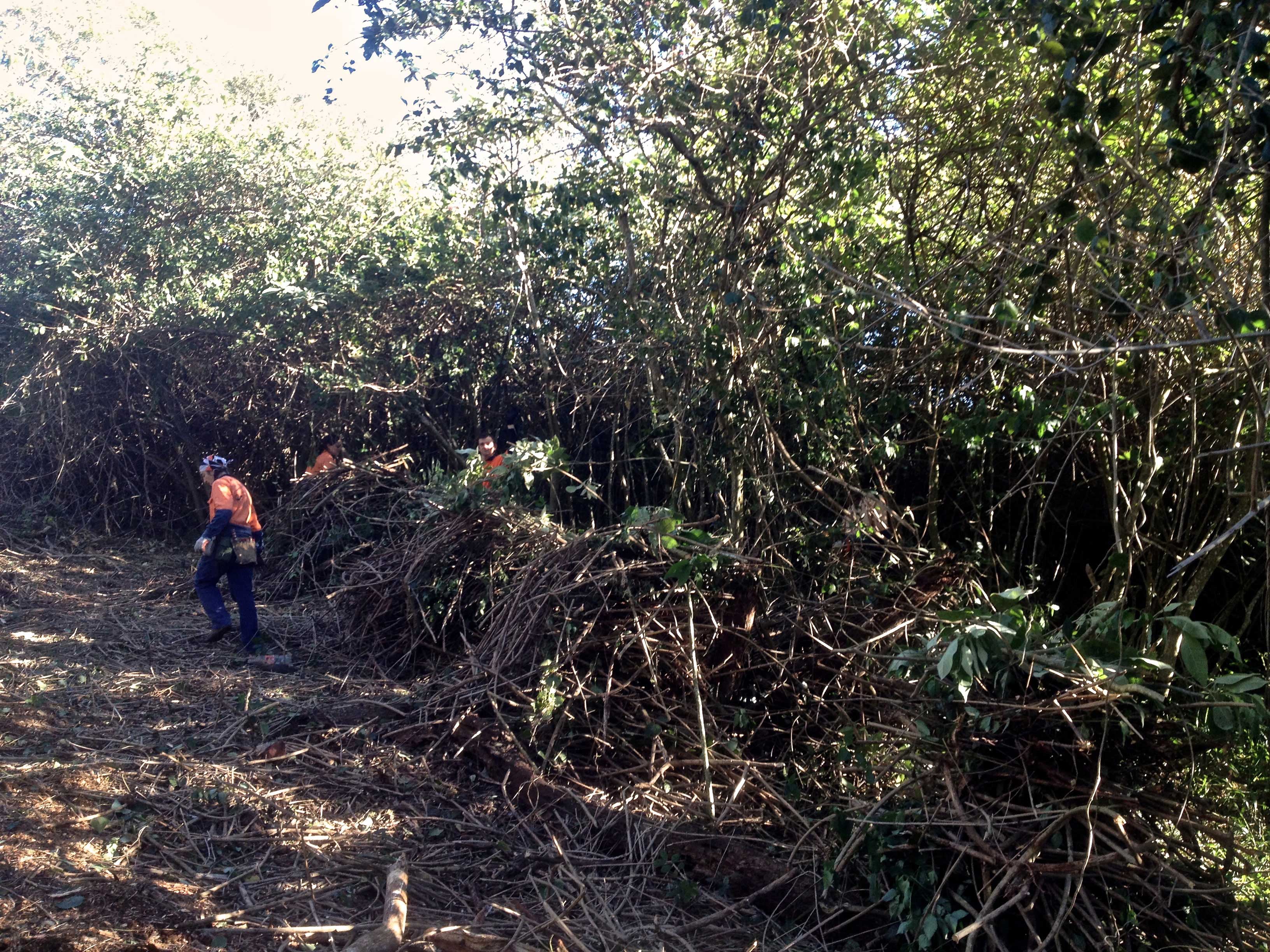
Annabella made her diary and sketchbook entries while living with her uncle Major Archibald Innes and her aunt Margaret Innes (nee Macleay) in the mid 1800s in an area that is the modern day outskirts of Port Macquarie. Margaret’s father was Alexander Macleay, who came to Australia in 1826 as Colonial Secretary. He was “already a Fellow of the Royal Society and an eminent person with a wonderful collection of entomology.”[1] By the sounds of it a very progressive father too, in that special, colonial way, who encouraged all six of his children, girls and all, into any scientific pursuit they could get their mitts on.
“Alexander Macleay’s household was unique…in the early colonial society of New South Wales because it was one of educated women. The girls there studied not just botany but entomology, zoology, ornithology, marine biology – all the other ologies – astronomy, horticulture and landscape gardening. They were very well educated indeed. They had a wonderful library that had fantastic features and its list of contents gives an insight…to the first family of intellectuals in New South Wales.”[1]
It was with Margaret’s guidance that Annabella’s keen interest in the botany of the Port Macquarie area grew and was documented with such acuity. And it was at that property that she documented in her sketchbook at least one of the first major environmental weeds that have ravaged this country. Pictured beautifully in one of her watercolour illustrations, the very first image featured in Karolina’s ‘A Botanical Life‘ article, is the plant Coastal Morning Glory (Ipomoea cairica) accompanied by the annotation that this plant “had entirely covered many of the trees around Lake Innes Estate.”[2] As explained in the audio transcript from the NMA’s ‘Spirit of Inquiry’ Landmarks series, “Margaret Innes had access to lots of botanical cuttings, because Alexander Macleay was part of that great network of people who were sending plants around the globe from Kew Gardens, that Sir Joseph Banks promoted, where they were transplanting things from one colony to the next, or from England out to Australia and other colonies as well. Margaret Innes is credited, or otherwise, with bringing into this country lantana – we don’t know whether we thank her for that or not.” Really?! Margaret also brought Bamboo to the area, and there’s “a huge canopy of bamboo that you can still see at the entranceway to what would have been the grand entrance of Lake Innes House, [as well as] a ginger plant…and the briar rose called the Macarthur rose. Until the 1950s and 1960s this whole site was engulfed by this stuff.”[1]
I keep mulling over in my head the fact that these were highly educated, scientifically minded people, who had travelled the seas to at least a few different countries and had access to a vast amount of knowledge of many aspects of the natural world. After all, the impact of weed incursion, even from ancient times, and more obvious things like the spread of human disease following colonial landings, such as in the Americas, were well known.
Intentions aside, the thing about bringing weed incursions, similar to all kinds of other environmentally threatening processes, is that weeds disrupt the relationships between species that have evolved over thousands, if not millions, of years. When relationships are disrupted and habitats are taken over, species diversity declines. Things die and they don’t come back. The common perception is that nature will recover, in some form, like you know, when all the dinosaurs died, and this seems to make species loss less of a pressing issue, because something stronger will fill the void: a kind of human-influenced species selection; the general homogenisation of everything. I’m certainly no expert, but there seems to be much more evidence to support the notion that healthy environs and bodies of all shapes and sizes (ours included) rely on diversity of symbiotic relationships to survive. Humans have evolved from these relationships and I believe we are being undone by disturbing these same processes and relationships. It is not going to be a quick thing, by the human eye, and it certainly isn’t pretty.
In the scheme of things, bush regeneration is just one avenue of the great clean up human kind is attempting in the post-colonial, post-industrial revolution era, and is running concurrent with a whole lot of mess-making still. The news is not all grim though. Some of the good things happening are that we have forward-looking researchers and policy-makers, some fluctuating government funding, a great army of volunteers (largely retirees), and environmental education trickling through the populace, and this is all making the clean up more possible. I think with a consistent effort we can turn the corner towards sustainability; towards more of a caretaker or stewardship mentality.
On my two days a week scrambling through the bush, my workmates and I spend a lot of time marinating on the mentality of people in their environment. Our work forces us to, especially on the urban edge where the tide of waste products, carelessness and sometimes intentional harm laps into the undergrowth. We’d often much rather be cackling about other things, but dealing with the issues, in a very practical way, I think helps us get on and work harder. Along with the ugly bits though, we also get to see some of the most stunning areas of bushland that not many people are granted access to and we get to interact with some amazing wildlife, such as that pictured in the below photos that I took at work. I personally am grateful for the opportunity to go bounding into the bush in ways I have never done before; I really do love it. My fingernails are dirty, I feel connected! I asked my workmate Mick for some insights from his many years of bush-regen’ing. His first comment was, “well it definitely attracts ‘characters’!” I chuckle, and have to agree. But mostly, from there on, Mick talks wistfully of the overriding, deep love of ‘the bush’, instilled in most of us from childhood, even though most of us grew up in the city. Mick is also the oracle of species identification on our field team and appreciates the way his job allows him the ability to “read” the bush more: “you know how long it will take to recover from things, how it will react”.
One of the big issues threatening the bush that we are yet to fully comprehend is the impact of our waste products, in particular the accumulation of plastics and toxins in the environment. At the rate that these products are entering the environment and now the food chain, we really have no idea how long it will take the bush and its ecosystems (including us) to recover.
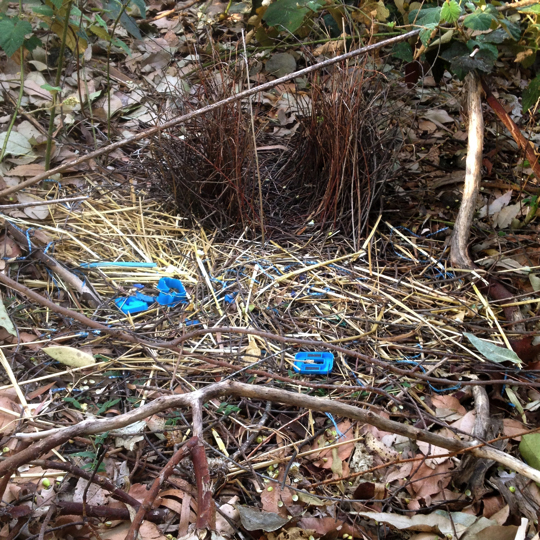
Although I’ve painted a bit of a grim picture of Annabella Innes and her contemporaries, I think her diligent and beautiful recordings of the natural world are an important document not just in the history of the Port Macquarie region, but in the history of the Australian bush. For me, first and foremost, they highlight the very necessary act of connecting with and observing nature in close detail. I think a scientific approach to the world is important now more than ever. Annabella also approached the natural world with wonderment and enthusiasm, and through my work as a bush regenerator, a mother and a teacher I hope to pass this same enthusiasm and positivity for the future of the natural world onto my children. That’s why I’m thrilled to be involved in the Frugal Forest project…
Un-trashing the Bush – The Frugal Forest project
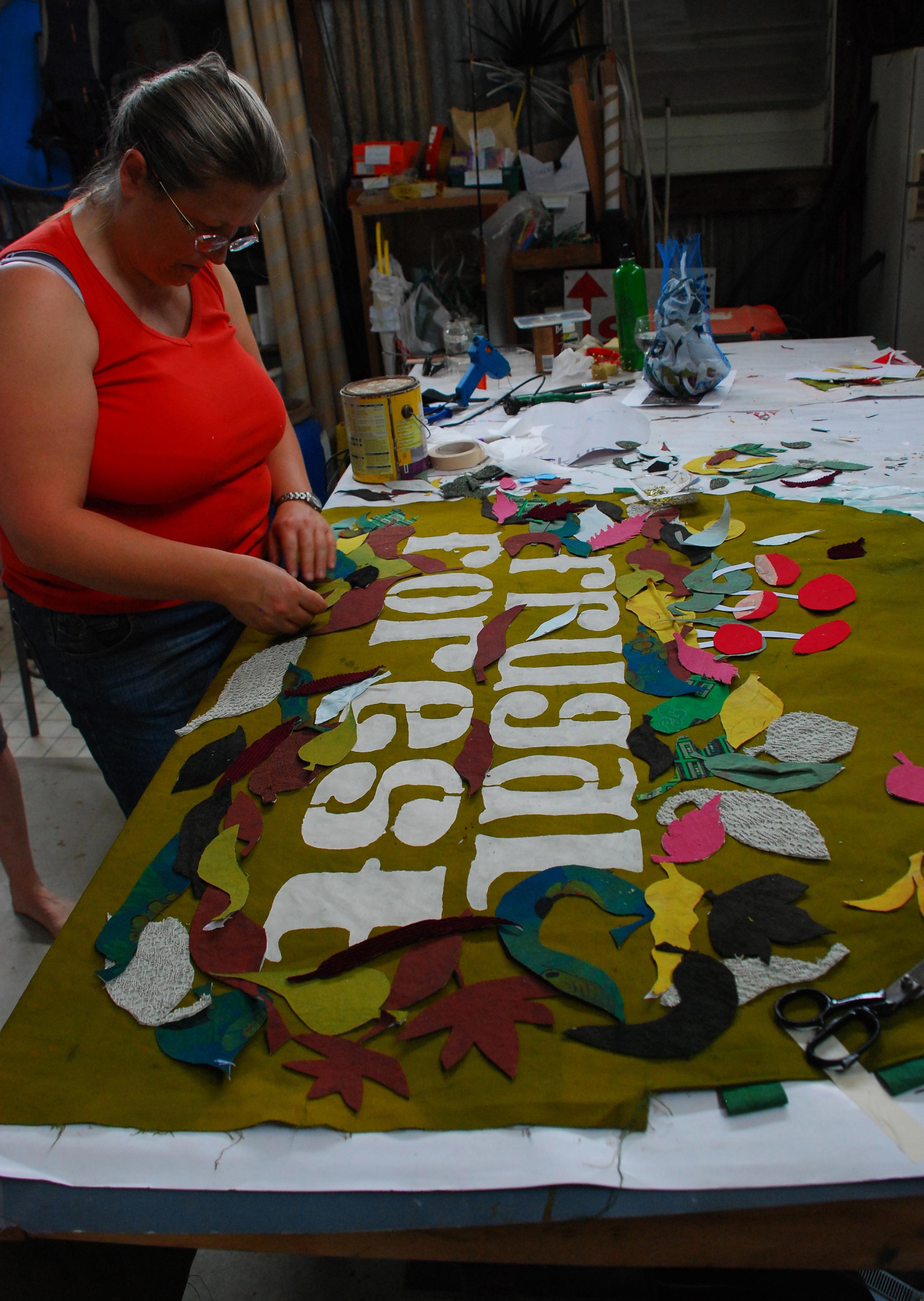
Bryony – The Frugal Forest project was seeded in Pappinbarra, inland from Port Macquarie, with a bunch of women who live and work surrounded by forest. It’s fascinating to see how, in the forest, every dead thing becomes a source of new life; if you get down on your hands and knees and have a rummage, you see that the leaf litter is a busy world of worms, insects, fungi, and microbial processes that are all breaking it down and helping to make that waste available as nutrients. This seems like a beautiful and important analogy for how a system can be sustainable, one that humanity should be trying to emulate.
In an ecosystem, there’s no dump; everything goes round and round. The way us humans play it, most of what we use goes out and down. It’s extracted from the earth, used briefly (only 1% of the products of industry are still in use 6 months after manufacture [3]), and then largely sent to landfill, where those precious resources become unusable and potentially hazardous. Even recycling is mostly ‘downcycling’, creating a material of lesser integrity or value. There’s a great book called ‘Cradle to Cradle’ (Michael Braungart and William McDonough [4]), which proposes a world where design and industry have a before-and-after consideration built in to every process; where are these materials coming from? Where will they go after this? What will they become next, and how can we help that to happen?
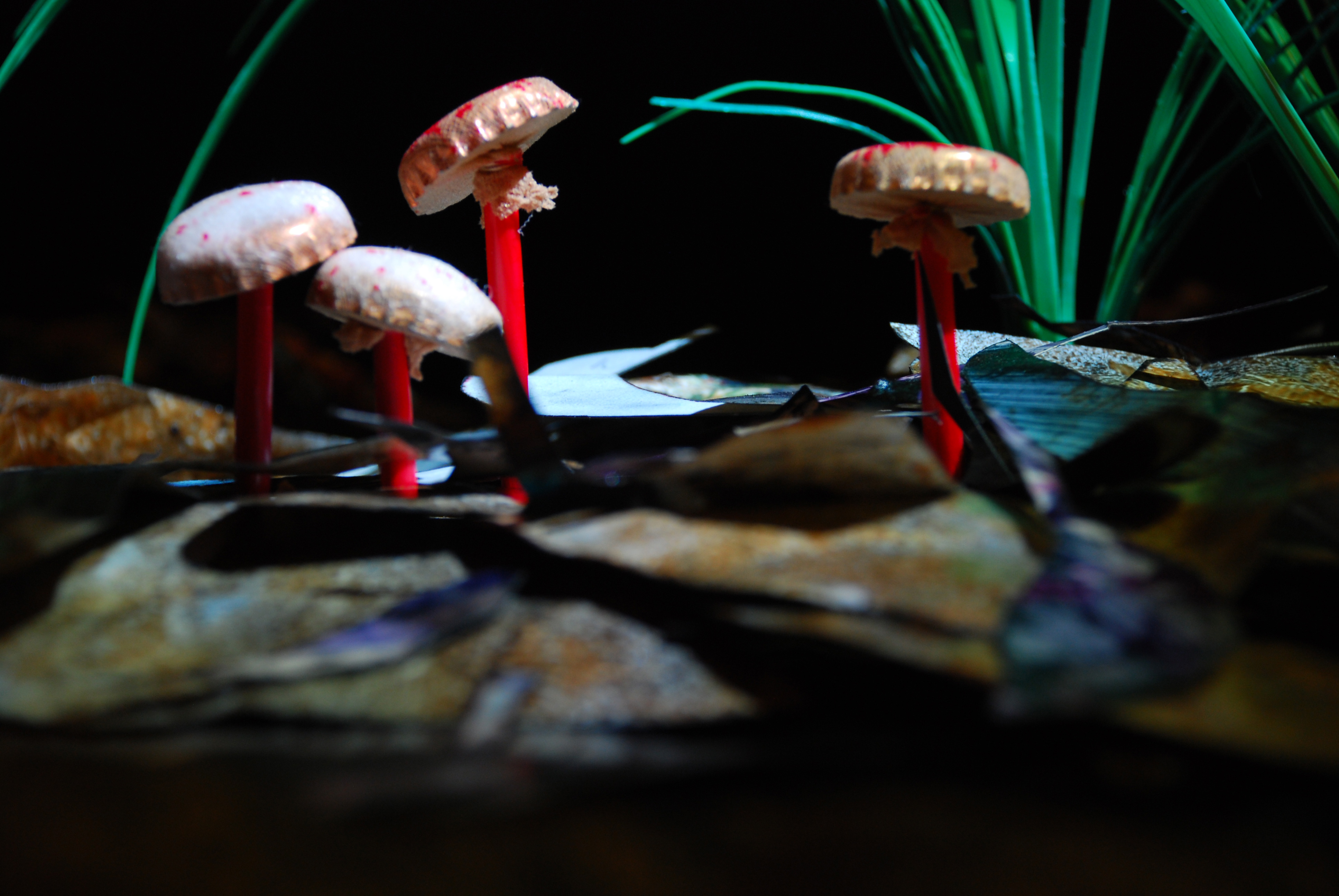
From a small beginning – a few fungi made of old stockings and bottle tops, some leaf litter from old photos, and a late-night photo shoot – the Frugal Forest project has grown (with funding assistance from Midwaste and the Australia Council) to include workshops all along the Mid North Coast, and thousands of hours of patient handwork by hundreds of participants.
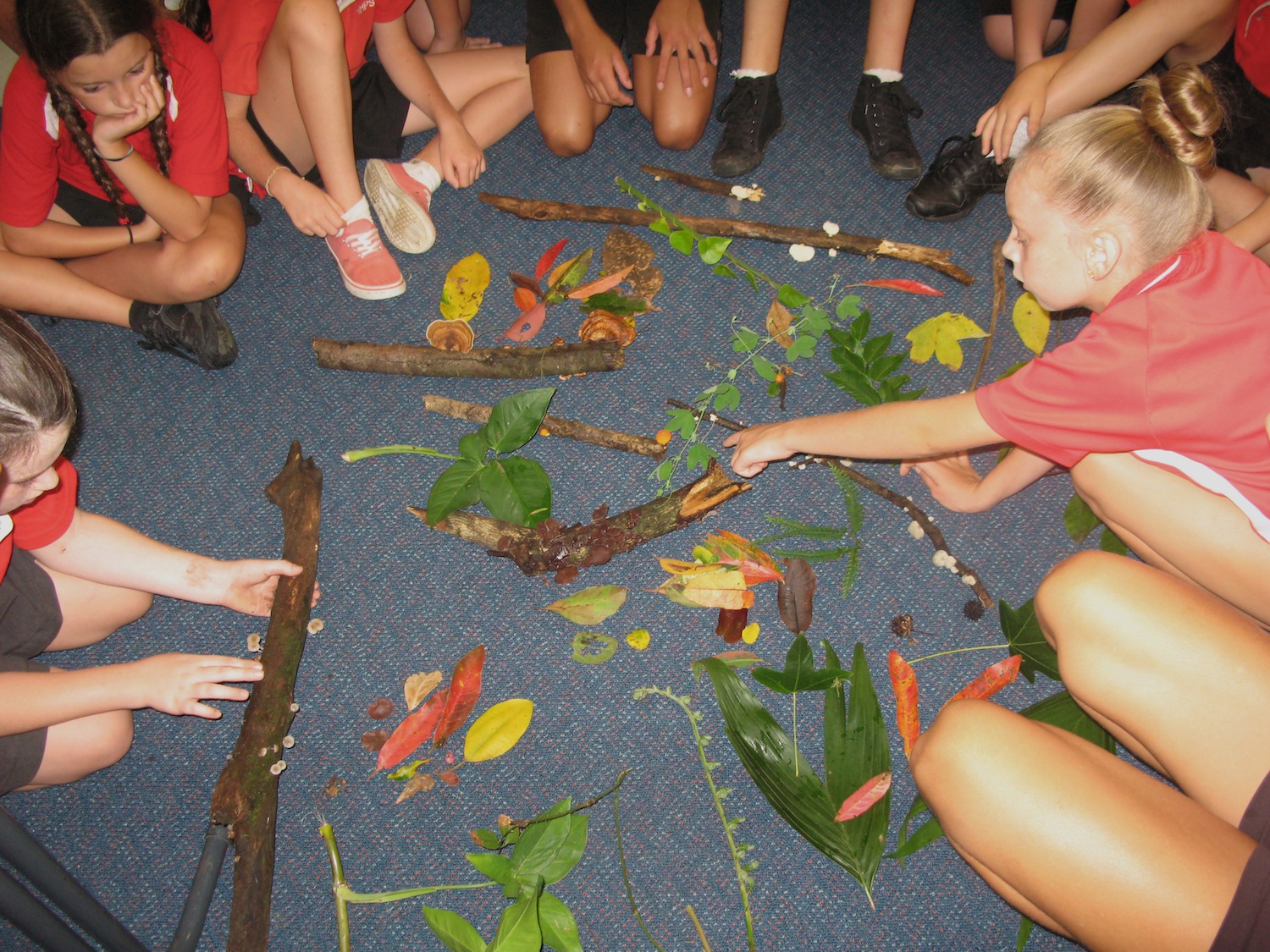
School kids, teenagers, local artists, rural mothers and market-goers have all had a hand in making palm trees from coffee cups and x-rays, or reeds from packing strap, or mossy understorey from mesh bags. We’re treating stuff that would usually go to landfill with new respect, learning about its properties (and also about all the hidden toxins in everyday objects!) and applying simple craft techniques to rework them into forest components.
It’s also become a reason to look more closely at plants as we pass; how leaves clasp the twig, how berries form, textures in bark and moss. The more you look, the more marvellous and infinitely complex it seems, this vast self-regulating system of interconnected organisms.
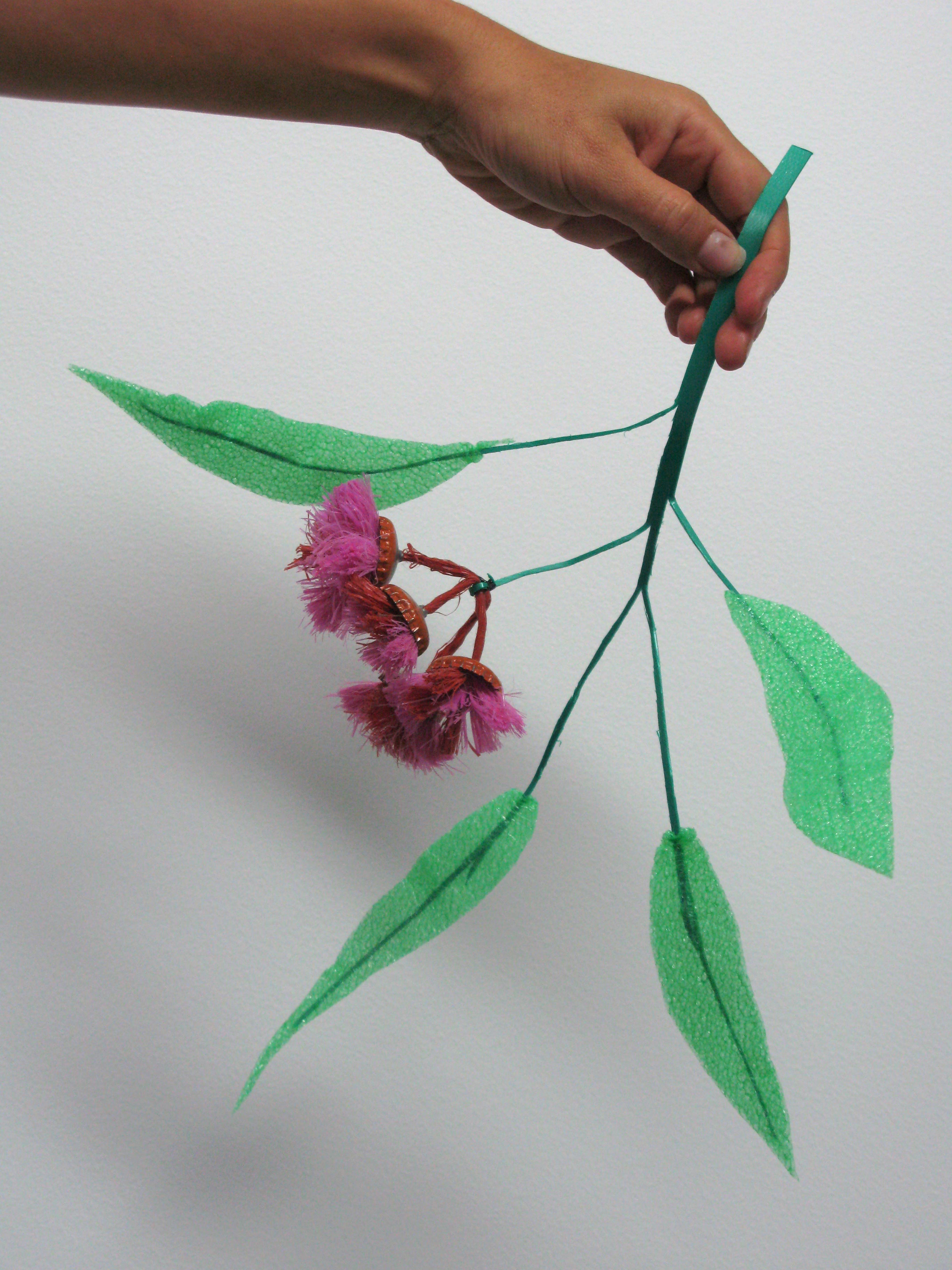
Local ecologists, botanists and bush regenerators are helping us to make the science make sense, so that each design in the Frugal Forest could occupy a real niche in an ecosystem and relate to an existing genus. One day – after about 5,000 hours of handwork! – we’ll have a rich, layered forest, dimly lit by shafts of light, that you can walk into, explore or sit within. All around you will be a soundscape, gleaned from the sounds of junk by the amazing composer Rae Howell, and played through a salvaged sound system.
We plan to tour it, to open a conversation about resources and what effect everyday choices can have on the planet. It needn’t be all doom and gloom – it’s a glorious challenge! Will we leave our kids with a planet of depleted resources and troublesome mess, or can we become creative, abundant members of a thriving and resilient ecosystem that can keep going, and going, and going?
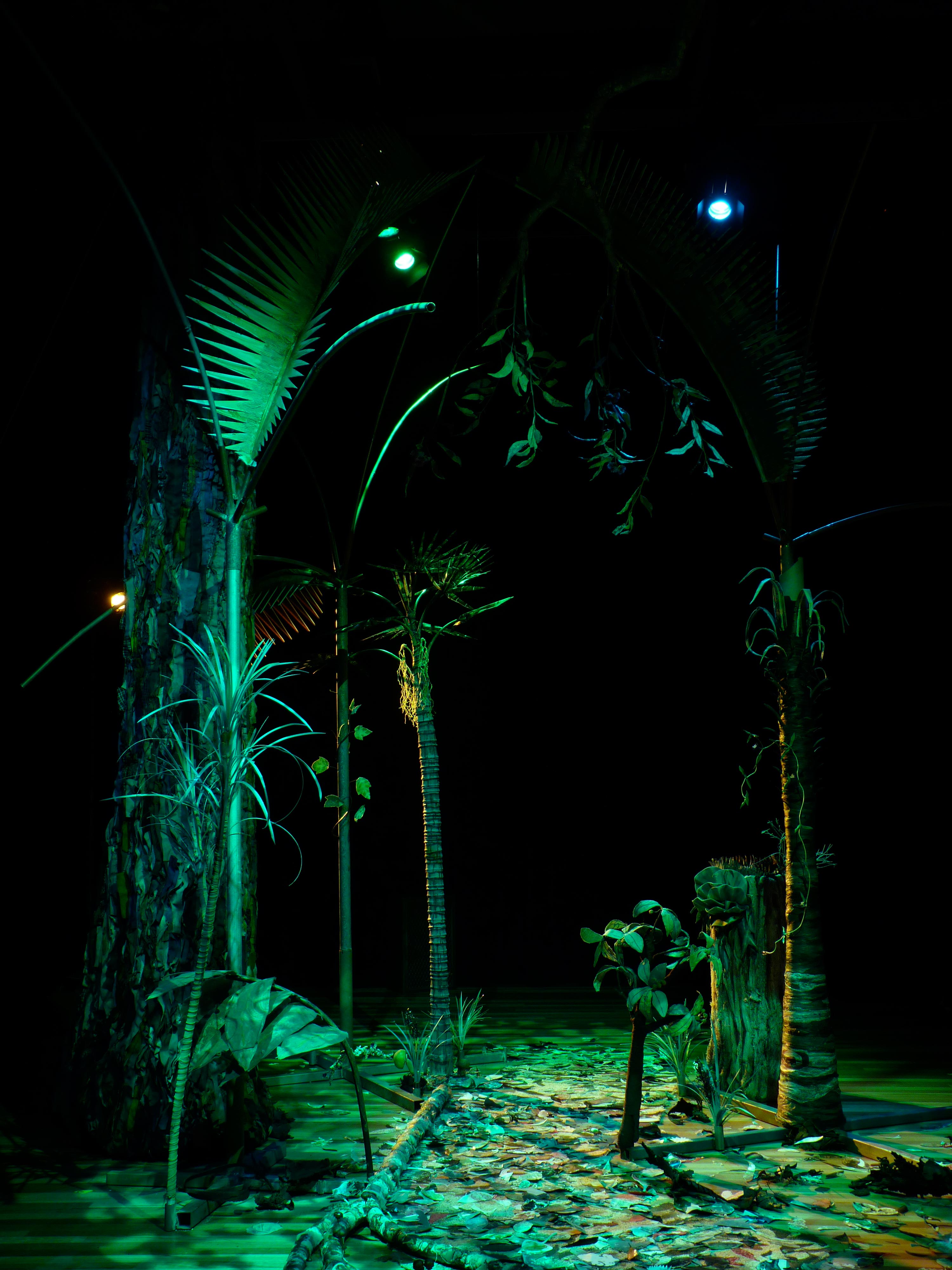
Title image: Denny, Chay’s daughter, in a hedge maze. Photo: Chay Khamsone.
References
[1] Roslyn Russell, ‘Spirit of Inquiry in Port Macquarie’, National Museum of Australia, Audio on Demand transcript, 13 June 2009. http://www.nma.gov.au/audio/transcripts/landmarks/NMA_Russell_20090610.html
[2] Karolina Kilian, ‘A Botanical Life’, The Museum Magazine, Issue 4, 2013. http://www.nma.gov.au/museum_magazine/issue_four/a_botanical_life
[3] Annie Leonard, ‘The Story of Stuff’ – Referenced and Annotated Script, 2007.
http://storyofstuff.org/wp-content/uploads/movies/scripts/Story%20of%20Stuff.pdf
[4] William McDonough and Michael Braungart, ‘Cradle to Cradle: Remaking the Way We Make Things’, North Point Press, 2002.
